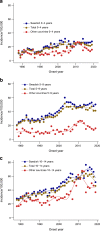The incidence of childhood-onset type 1 diabetes, time trends and association with the population composition in Sweden: a 40 year follow-up
- PMID: 36264296
- PMCID: PMC9807495
- DOI: 10.1007/s00125-022-05816-0
The incidence of childhood-onset type 1 diabetes, time trends and association with the population composition in Sweden: a 40 year follow-up
Abstract
Aims/hypothesis: During the 1980s and 1990s, the incidence of childhood-onset type 1 diabetes more than doubled in Sweden, followed by a plateau. In the present 40 year follow-up, we investigated if the incidence remained stable and whether this could be explained by increased migration from countries reporting lower incidences.
Methods: We used 23,143 incident cases of childhood-onset type 1 diabetes reported between 1978 and 2019 to the nationwide, population-based Swedish Childhood Diabetes Registry and population data from Statistics Sweden. Generalised additive models and ANOVA were applied to analyse the effects of onset age, sex, time trends and parental country of birth and interaction effects between these factors.
Results: The flattening of the incidence increase seems to remain over the period 2005-2019. When comparing the incidence of type 1 diabetes for all children in Sweden with that for children with both parents born in Sweden, the trends were parallel but at a higher level for the latter. A comparison of the incidence trends between individuals with Swedish backgrounds (high diabetes trait) and Asian backgrounds (low diabetes trait) showed that the Asian subpopulation had a stable increase in incidence over time.
Conclusions/interpretation: In Sweden, the increase in incidence of childhood-onset type 1 diabetes in the late 20th century has been approaching a more stable albeit high level over the last two decades. Increased immigration from countries with lower incidences of childhood-onset type 1 diabetes does not provide a complete explanation for the observed levelling off.
Keywords: Children; Immigration; Incidence; Time trend; Type 1 diabetes.
© 2022. The Author(s).
Figures




References
-
- Patterson CC, Harjutsalo V, Rosenbauer J, et al. Trends and cyclical variation in the incidence of childhood type 1 diabetes in 26 European centres in the 25 year period 1989–2013: a multicentre prospective registration study. Diabetologia. 2019;62:408–417. doi: 10.1007/s00125-018-4763-3. - DOI - PubMed
-
- Patterson CC, Karuranga S, Salpea P, et al. Worldwide estimates of incidence, prevalence and mortality of type 1 diabetes in children and adolescents: results from the International Diabetes Federation Diabetes Atlas, 9th edition. Diabetes Res Clin Pract. 2019;157:107842. doi: 10.1016/j.diabres.2019.107842. - DOI - PubMed
Publication types
MeSH terms
Grants and funding
LinkOut - more resources
Full Text Sources
Medical

